

 |
 |
The western sky was full of evening stars. From my high vantage point they looked quite a sight above the dark outline of the Sperrin Mountains. Distant cumulus clouds dropped long lines of showers along the mountain's eastern flank. Every few min's a bright flash of lightning lit up the entire western dome of the sky briefly illuminating the clouds from behind. Some of these were white, others a spectacular red colour. These distant thunderstorms continued to break up the serenity of the night sky over the west coast of Ireland. They had been doing this for the previous two nights. I had spent the last two hours watching these distant storms, taking exposures, and hoping they would move closer. They certainly were doing so but at a painfully slow pace, some of those flashes were getting brighter as the air mass approached the Sperrins from the W. The icy tops of cumulonimbus clouds (cbs) could be seen along the skyline. The storm's white wispy anvil was very distinctive against the background stars. When they arrived on view the electrical activity ceased. I was using the time productively by taking exposures of the sky with clouds, stars, and car trails, hoping to catch one of those magnificent anvil crawlers. It's amazing how the freezing cold and gusting winds have little effect on you when something exciting is happening. I was located in a field in the middle of nowhere, the opaque darkness under a treeline hid the shapes of a dozen cows which lay sleeping and sheltering from the wind, I had almost tripped over them when I first arrived. The waxing gibbous Moon was climbing higher in the E and by using the hand method for measuring angles in the sky I noted that the Moon was over 42 degrees high. That was too high for a moonbow.
This was the reason why I was out in the first place. It was my second or third night out hunting for lunar rainbows or 'Moonbows' and this time I had no success. It was a similar story on the previous nights too. I had made a vow several weeks ago that I would make a serious effort every month to photograph this elusive phenomena if the conditions were present for their formation. A number of days earlier a type of Ana cold front swept across the country causing severe weather and even a tornado. The unstable air mass behind it brought a series of showers through my area, first from the SW, then later in the night from the W along with a risk of lightning. This was a good set-up for a moonbow. I was determined not to give up though and decided to stick it out until I caught another.
The two main ingredients are showers and a bright Moon phase. This might seem simple enough but there are many other minor details which need to be present to catch one. The Moon has to be less than 42 degrees (84 full Moon diameters) above the horizon. A Moon located just under this visibility ceiling would cause a bow extremely low on the horizon. They can be seen, however with horizon cloud and atmospheric extinction the bows will be faint or invisible. A low Moon will generate a very large bow which is extremely difficult to fit in the frame of a camera unless you have something like the Canon 10-22mm wide angle lens which just might do it. The standard wide lens on my camera is a 28mm so this creates problems. Stitching images together during the processing stage is one way around this however I prefer to make the most of my original capture without stitching. The best thing to do is catch the Moon at a height when it's one quarter of the way to the zenith. This will produce a very bright bow at a generous height.
The other problem are the weather conditions. I always use the online Met office radar to work out where the showers are, their intensity, and in what direction they are moving. With this in mind you will be confident that a bow will form somewhere. With the Moon at your back and falling precipitation in the sky opposite the Moon, a bow will be seen. The problem is not if a moonbow will form but when. You can get lucky and catch one within min's but more than likely you will have to put in a session of several hours to catch more than good one. Going back to the Moon, this will generate a succession of evening and morning 'window periods' depending on it's altitude and it's position on the ecliptic. Example: in the days before a full Moon the Moon itself will already be visible in the day time sky. As soon as the sky gets dark it's already quite high in the E and rapidly nearing the 42d mark so you need to take advantage of that short window. The second window is during the pre dawn hours when the Moon drops below 42d. This is a favourite time of mine because the lowering Moon will cause a bow with an ever increasing height as the min's tick by. This height seems to occur much more rapidly than you would think. If you have ever watched the disk of the Sun set over a tree or mountain I'm you will have noticed how rapidly it sets. After full Moon phase the evening sky is the place to look, this window will get longer in length with each night, I think this is a very good time to spot moonbows. Later when the Moon is in the waning gibbous-last quarter phase you will be heading out later in the night or during the early morning hours. Again, the season and angle of the ecliptic will cause these window periods to vary during the year.
To cut a long story short I had put in about seven nights in total which added up to approximately 16 hours in search of Moonbows. Success took it's time to arrive though. On the fourth night I was out again for several hours and this was when I was seriously wondering why I do this. It seems that there has barely been a day or night this year when I haven't been soaked and cold due to the pursuit of some day or night time phenomena in the sky. I was standing in a field getting battered by squalls, rain, sleet, and I was feeling quite miserable. I could see the warm glow of distant lights from homes, and from the town of Maghera. It was a Saturday night, some people where relaxed on their sofas watching television, and I thought of the others around my age who would be out for the night in clubs drinking. Yet here I was standing in a field, jumping on the spot to keep warm and asking myself that same question. Why am I standing out here looking for a phenomena which most people have never even heard of?. I couldn't find an answer so I decided that I wasn't going home until I caught another Moonbow. I can be very single-minded and stubborn at times.
My luck soon changed after this because I managed to catch a colourful but faint complete bow. Success!!. Even though the bow was faint it was still very attractive. That alien looking arc of light against the stars left me thrilled. I think the Universe provided me with the answer. I do this because I like the thrill of the hunt, I enjoy the discomfort and long hours of waiting because when you finally catch what you are after it's the best feeling of satisfaction in the world!. I was well and truly hooked again. To add the icing on the cake more flashes of lightning pulsed in the W sky. Seeing a moonbow and lightning at the same time was a new 'first' for me. I was also aware that my nocturnal activities hadn't gone unnoticed. Somehow a driver managed to spot me in the dark field and spent 10 min's slowly driving back and fourth along the entrance to the field wondering what I was doing. He must have spotted the glow of my LCD screen in the darkness and thought aliens had landed. He eventually drove away in a rush. This set the scene for two more relentless moonbow sessions.
November 10/11th 01.30 - 03.30 UT
This was a night I felt would be guaranteed to produce a moonbow. I planned an early morning session when the Moon dropped below 42d. It was now at a fairly bright waxing gibbous phase well placed in the SW. It was a cold blustery starry night and a convective outlook had been issued for t-storms. The showery conditions were exactly what I wanted and the radar confirmed plenty of these so I went straight out. I didn't know for sure exactly where I was going to go so I tried different locations when a heavy shower suddenly passed over me, then a bow formed in sec's. I was in a bad position on a narrow country road flanked on both sides by trees and hedgerows. This was followed by more distant flashes of lightning. Soon I could see some very decent looking convection and even mammatus hanging down in front of the Moon. This was already turning into an interesting night.
I relocated to better vantage point on a country road. I was amazed to see a huge cb rapidly closing the gap. Considering the time of year, and the fact that it was night, I was surprised how good it looked. The leading edge was like a huge black mountain approaching. It hit and produced intense sleet turning the place extremely dark. I was expecting this to throw out a c-g at any moment. As it passed over another moonbow formed on the rear side of it's intense precip curtain. It was a complete blow with striking colours so I took a few exposures while the camera got soaked. The images didn't turn out very good because I was looking into a dark background of rain with weak moonlight filtering through the anvil of another cb on its way in from the W. Looking directly overhead I was very impressed by how solid the anvil looked. There must have been a good updraught present.
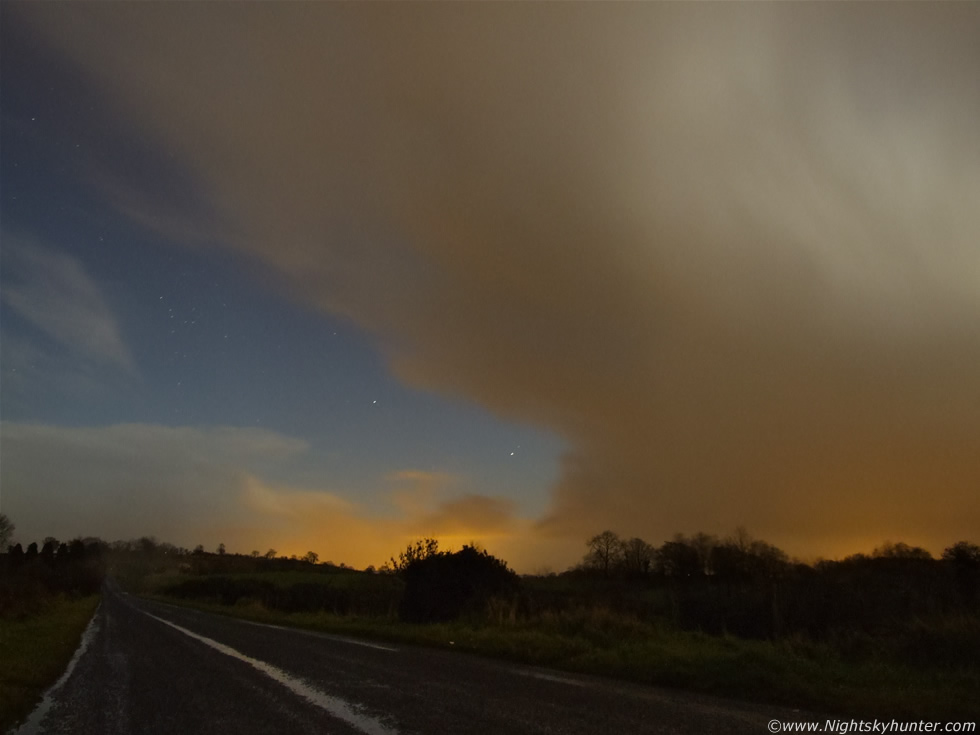 |
02.56 UT. Looking NE at the rear of the retreating cell. You can see the anvil sweeping upward to the W (L). It did the same on the other side and extended above and beyond the 28mm field. Weak mammatus was forming also. The star to the R is Beta Leonis. The fainter cluster of stars to the L of this is the cluster 'Melotte 111' in Coma Berenices. Upper L of this is the Alpha of Canes Venatici. This was a 30 sec exposure, look how wet the road was, more cells could be seen in the distance so I decided to stay out. I was bound to get another bow sometime.
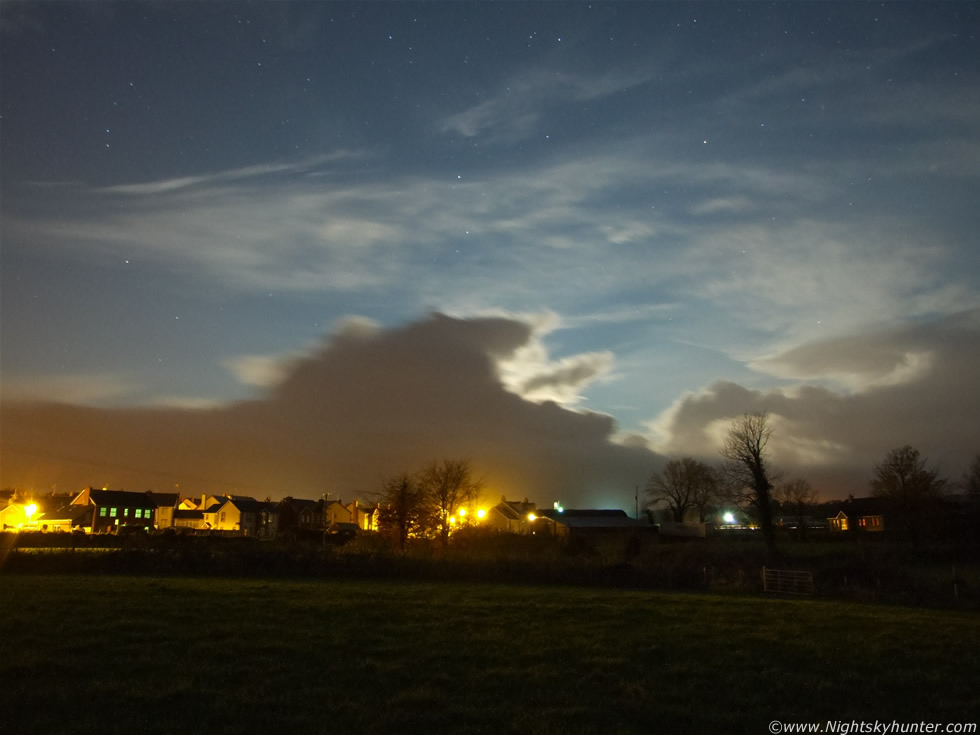 |
04.22 UT. It was another long wait before I had a chance of catching another bow. It stayed very clear and dry so I got off the road and entered a field. Despite the unsociable hour of the night there was still the odd driver on these narrow roads who liked to break the speed limit in dramatic fashion. Some of them are drunk too!. It's a very dangerous place so I stayed off it. I was about to give up when a nasty looking line of convection arrived over the mountains from the NW. The image faces SW-W showing the shower clouds gathering. They look soft and bright on the exposure but with the naked eye they were solid black in profile and very sinister looking. They slowly headed my way while blocking stars from the sky one by one turning the bright sky gradually darker. A huge thunderhead proudly rose up from the top of the line. This line of cbs would be my last chance of the night to catch a bow. On the image the convection is moving towards me and to the L. The anvil is at centre, curving to the R with mammatus. A small flanking line is visible in 'stair case' fashion to the R. Another anvil is visible also. How good is your star knowledge?, above centre is Aries and Triangulum. To the R is Andromeda with M31. Lower L is Cetus. The Moon was getting very low in the sky and hidden by cloud. I have learned alot about observing Moonbows over the last five nights. Aside from the usual criteria to get a bow, you also have to take into consideration the horizontal extent of the rain curtain, the size of the raindrops, and the distance between you and the rain. Add to this a dark or semi clear background and you will have a different bow every time. You need the correct conditions, luck, and great dedication to catch a photogenic Moonbow. I figured this was my last chance at Moonbows but I turned out to be wrong.
November 11/12th 04.00 - 05.30 UT
This was an unexpected surprise!. The forecast gave the early morning hours to be dry and clear with no rain so I ruled out the chance of any bows. I got up for a pre dawn session in the hope of observing some Taurid fireballs. That was the plan anyway, before I went out I checked the radar and was surprised to see some showers showing yellow and green echoes. They were of moderate strength and seemed to be heading straight for my location. I figured that they should be visible visually when I went out. So out I went not knowing what to expect. Soon I was on a country road and behind me some beefy looking cu towers with precip where closing in...
 |
04.05 UT. Within five min's a moonbow suddenly formed!. Looking NE. The bow was colourful and gradually growing in length. The bright star below is Arcturus. Above is Canes Venatici and Ursa Major. The tail of Leo to the upper R. This was ISO 400, 30 sec's using the 28mm lens at F/4. I tried the lens wide open but it blew out the cloud tops. Behind me the Moon was almost at full phase with a slight terminator on the western limb. It was a beautiful sight.
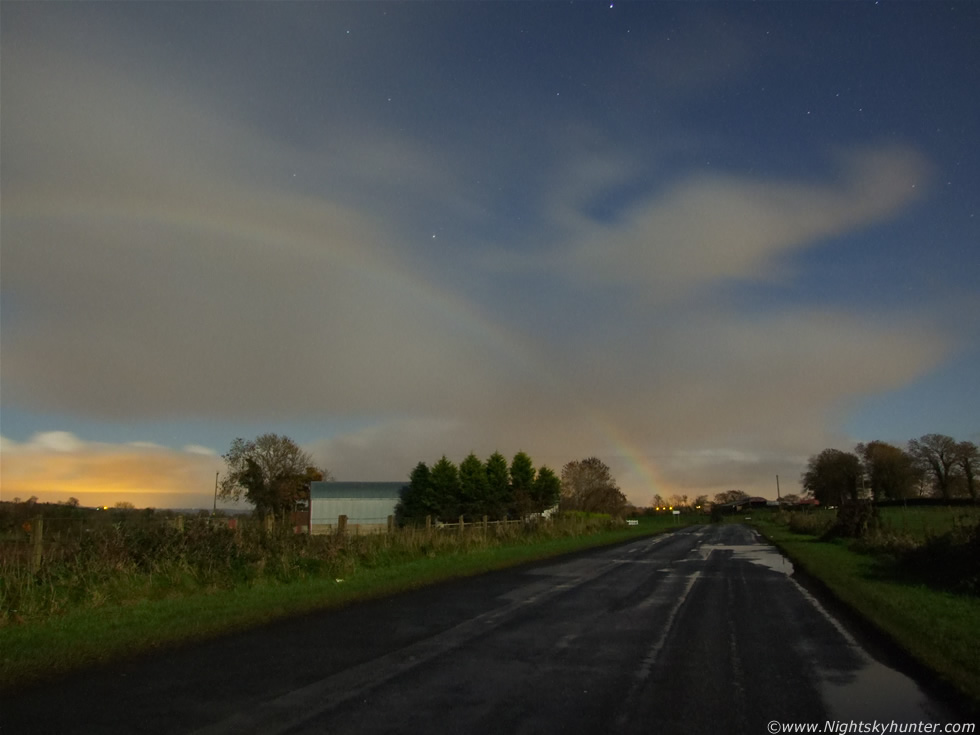 |
04.13 UT. The bow was now complete. I deliberately composed the image with the R bow base at the bottom of the distant road. These are low resolution images which is why they look a little soft. The original images are much better. Those clouds are further away in the distance than they seem on the image. The bow was actually forming on a spray of raindrops blown down-wind from the showers behind me. This produces the most photogenic bows against a starry sky.
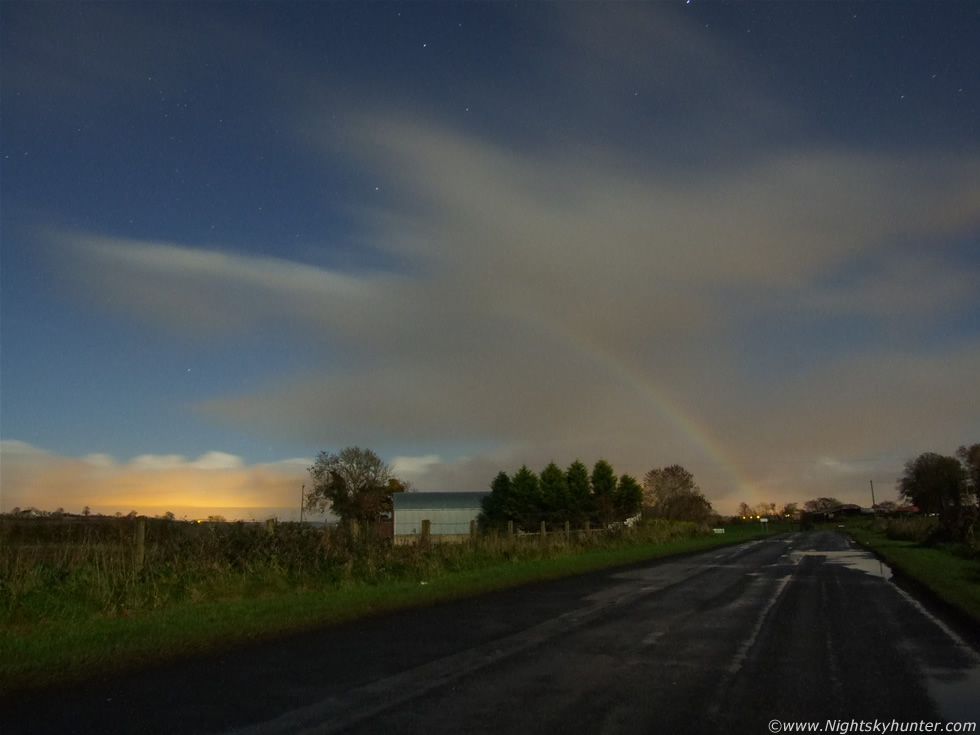 |
04.16 UT. Leo is at the top of the frame. Virgo can be seen to the lower L in the twilight.
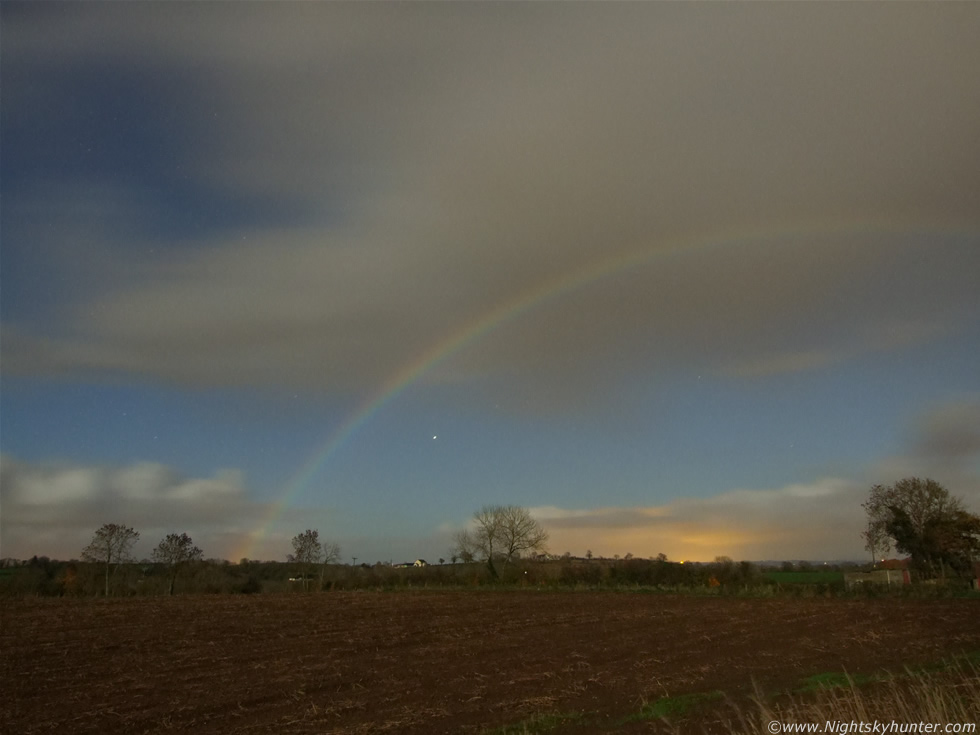 |
04.33 UT. I ended up observing half a dozen bows during this period but this one was the prize of the night. Looking NE again at a good quality primary moonbow with Arcturus below. The mottled structure in the cloud is the rain drops falling. As you can see it doesn't take much rain to produce a bow in the first place. This was such a wonderful sight. The night was mostly clear, completely calm, and absolutely dead silent!. It was as if no life existed around me. I never seen or heard a single car on the road the entire time. This treasured atmosphere under the crisp starry heavens felt very special. I almost felt like an intruder in the night. A few Taurid meteors zipped into the N. One of them almost made it into the image. I was crossing my fingers in the hope that a fireball would enter the field. A fireball and moonbow in the same image would be a rare sight. I don't think such an image has ever been taken before as far as I'm aware.
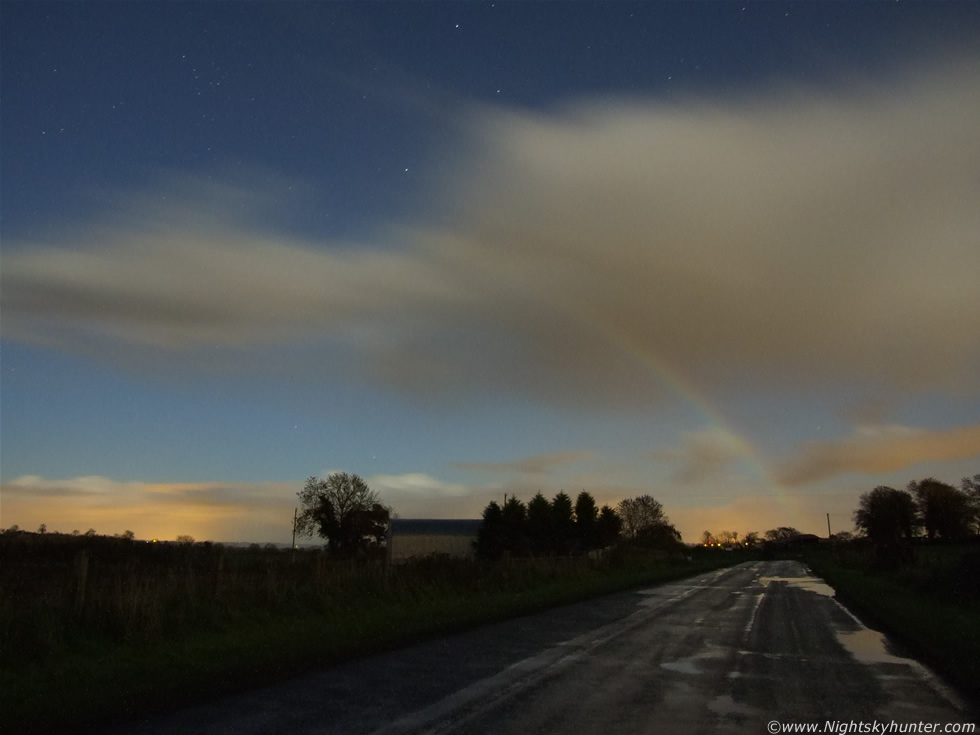 |
04.35 UT. Back to the eastern section. Because moonbows are an optical phenomena you can actually have some control over the image. By moving your position the bow will appear to move also. Earlier the R base was over that barn, so I moved further to my N, to the other side of the road. This way the bow moved to the end of the road where I wanted it.
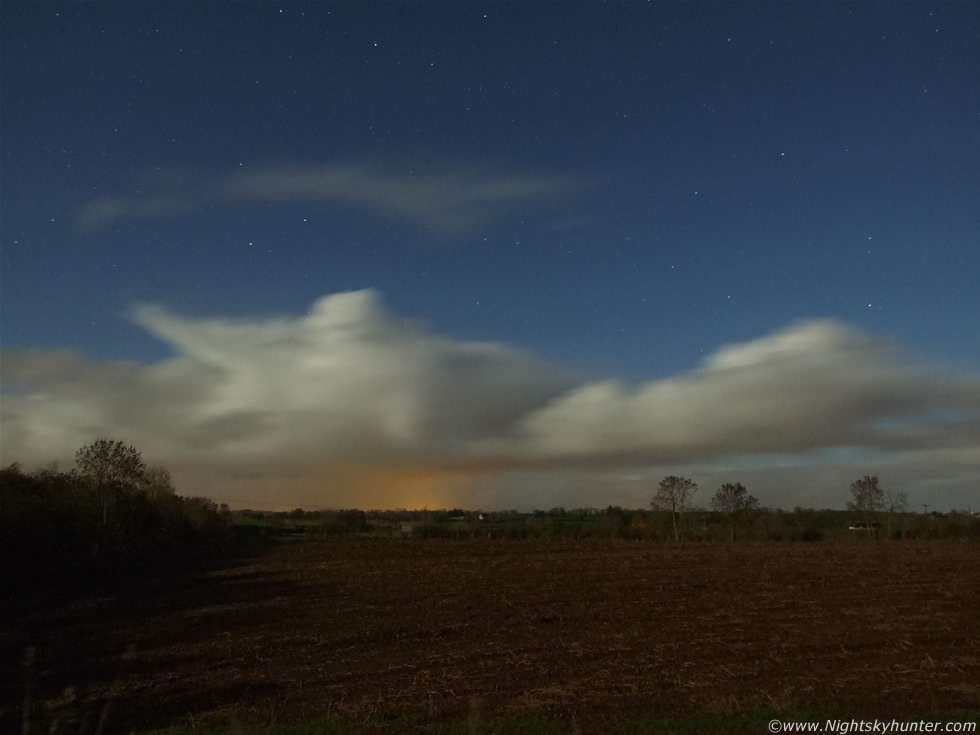 |
04.48 UT. I thought that was the end of the show until I seen this line of convection to the N. It was moving from L to R so I decided to wait. A shower formed below the central tower but it looked very far away. I would wait until it moved further E where I predicted a bow fragment just might form. I was really clutching at straws now. The constellations on the image from R to L are Bootes, Hercules, and Draco.
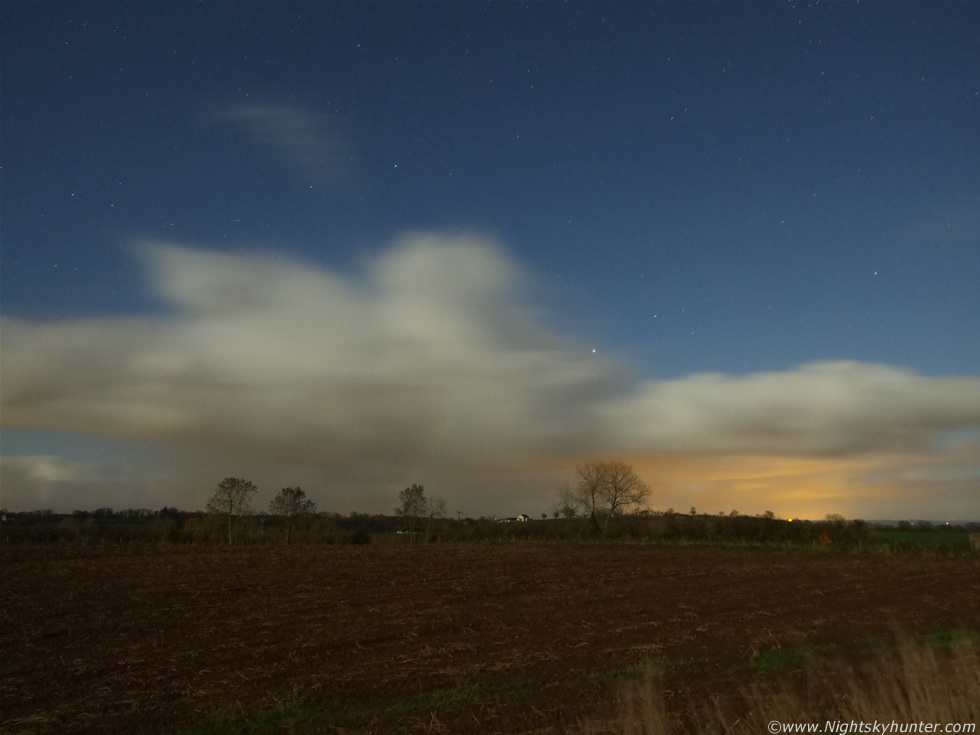 |
04.56 UT. The prediction was a good one. A faint coloured bow base formed directly under the tower then the session came to an end. The convection was drifting away into the distance leaving a stunning clear sky in it's wake. I just stood there enjoying the stars, I stayed out until 05.30 then called it a night. This was an extremely successful session. Sometimes it's the unplanned nights which turn out to be most productive!
I will continue to seek out more moonbows each month in the hope of getting a particularly unique image. I would like to take this opportunity to correct an out-dated misconception about moonbows. I have read in books, and on the internet, time and time again that because the full Moon is about half a million times less bright than the Sun, the brightest moobows usually appear colourless because the human eye can't perceive the colour of extremely faint light. From my own experience I can tell you that this is NOT true. I have 'perceived' vivid colours in every moonbow I have seen to date . However, the eye sight of the observer must also come into play. My Sister has seen a number of moonbows at the same time as I have and she seen the colours with ease. Try it out for yourself. I will end this report with a visual observation made by C .L. Brook (date unknown). This is from a book I have in my collection called 'Out Of The Blue' by John Nylor.
''Yesterday evening I was fortunate enough to see a most beautiful example of a double lunar rainbow; the primary bow was very bright, quite complete, and showed prismatic colours most clearly; the secondary bow was faint, but also almost complete, though the colour was clearly discernible; the appearance lasted from 9.10 to 9.30 pm. Both rainbows were apparently projected on the background of absolutely clear sky, so that at 9.20 I could clearly see the third magnitude stars in Ursa Major shinning through the primary bow; this apparent absence of cloud is not infrequent with a solar rainbow, but I have never seen it before in the case of the lunar rainbow. The softness and brilliancy of the whole phenomena was most remarkable''.
Martin McKenna